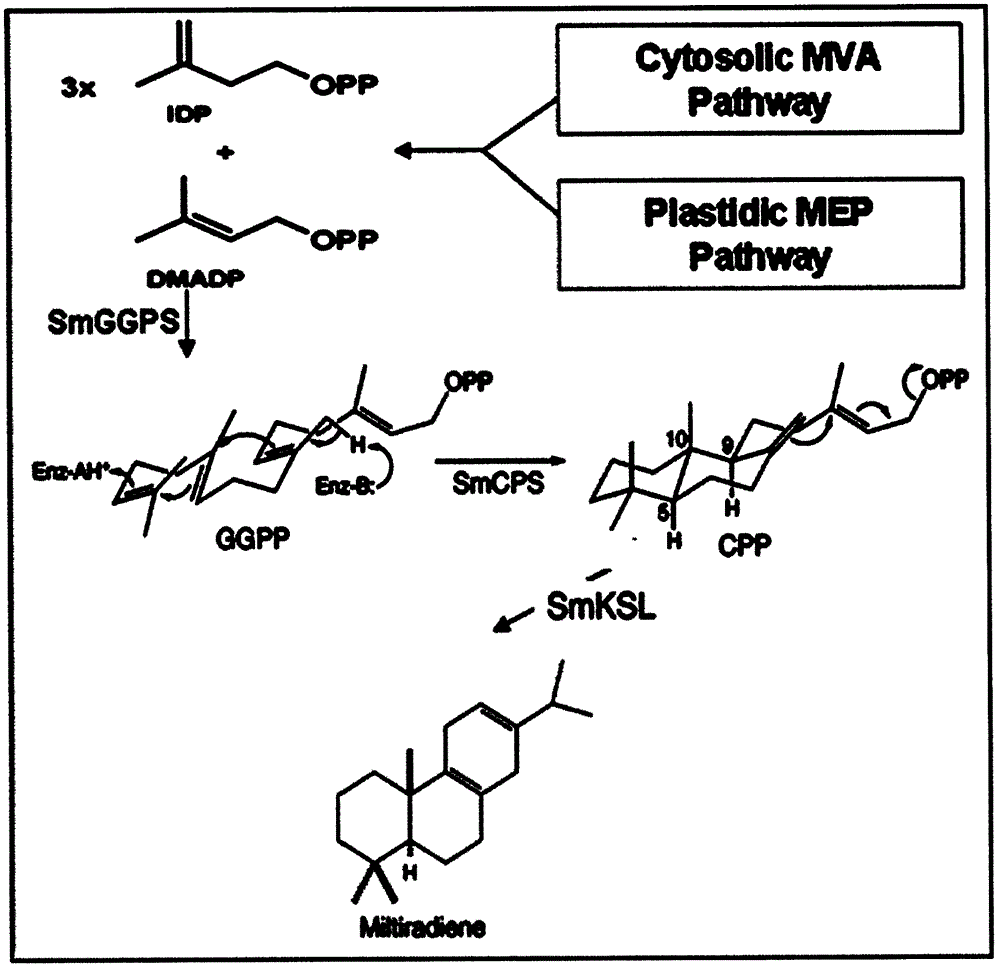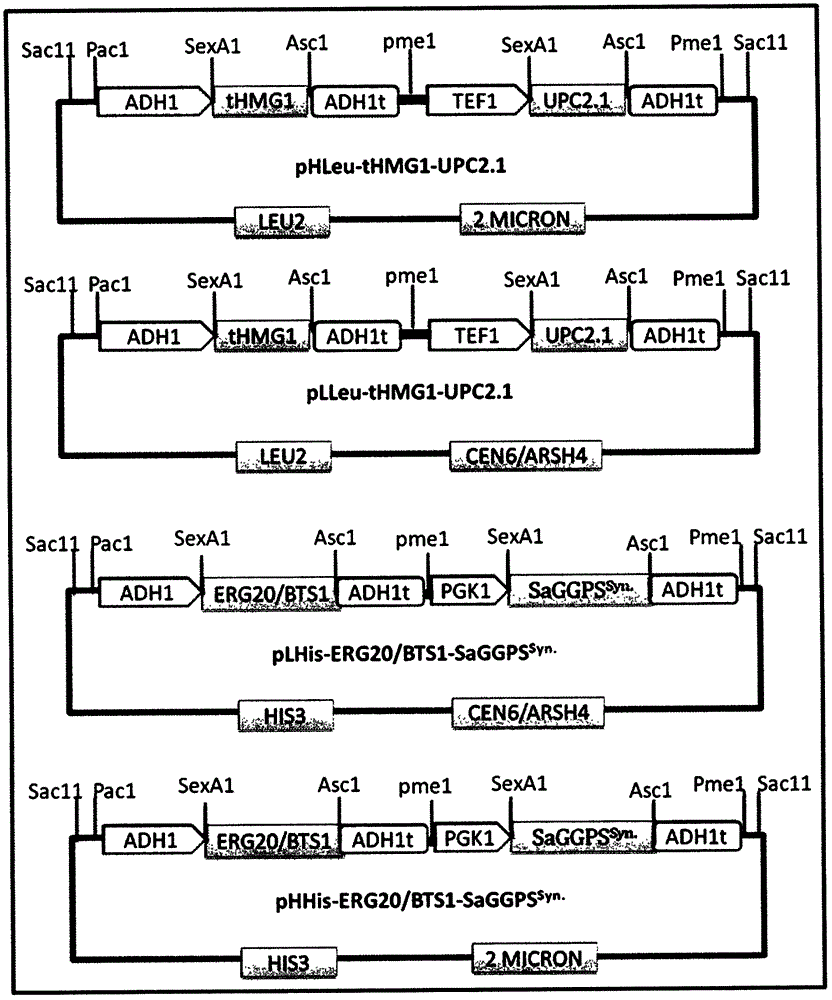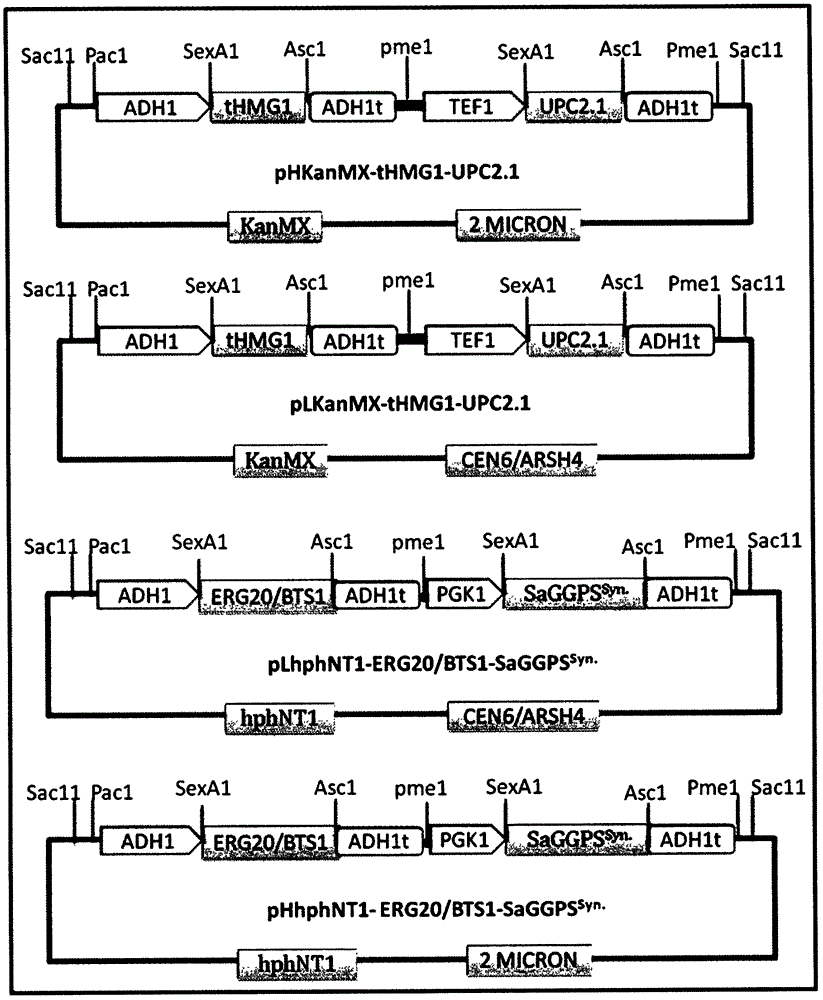Saccharomyces cerevisiae genetically engineered bacteria producing hypotanshinone diene and its construction method and application
A technology of hypotanshinone diene and genetically engineered bacteria, which is applied to the field of Saccharomyces cerevisiae genetically engineered bacteria producing hypotanshinone diene and its construction and application, which can solve problems such as unsatisfactory results
- Summary
- Abstract
- Description
- Claims
- Application Information
AI Technical Summary
Problems solved by technology
Method used
Image
Examples
Embodiment 1
[0056] Embodiment 1, the cloning of gene element
[0057] The cloning of genetic elements is divided into the following five steps:
[0058] (1) Yeast DNA extraction
[0059] Pick bacterial plaque (Saccharomyces cerevisiae BY4742) in YPD liquid medium (recipe: 1% Yeast Extract (yeast extract), 2% Peptone (peptone), 2% Dextrose (glucose), 30°C, 200rpm, culture 24h. 10000g , collect the bacteria in a 1.5ml centrifuge tube for 5 minutes, wash twice with water, resuspend the bacteria in yeast wall-breaking solution (25ul yeast wall-breaking enzyme, 470ul sorbitol buffer, 5u lβ-ME), and incubate at 30°C for 1h After centrifugation; cells were resuspended in 500ulTENTS buffer (10mM Tris-HCl, pH 7.5; 1mM EDTA, pH8.0; 100mM NaAc; 2% triton-100; 1% SDS), in a water bath at 60°C for 1 hour; extracted with phenol / chloroform Extract 2 times; add 3 times the volume of EtOH to the supernatant, 1 / 10 times the volume of 3M NaAc, and place it in the refrigerator at -20°C for 2 hours; centrif...
Embodiment 2
[0076] Embodiment 2, the cloning of regulatory element
[0077] Using Saccharomyces cerevisiae genomic DNA as a template, use the primers in primer list 4 to amplify the promoters of PGK1 (750bp), TEF1 (450bp) and ADH1 (1500bp), and the terminator ADH1t (158bp). The amplification system is: NewEngland Biolabs Phusion 5Xbuffer 10ul, dNTP (10mM each dNTP) 1ul, DNA template 20ng, primer (10uM) 1ul, Phusion High-Fidelity DNA Polymerase (2.5U / ul) 0.5ul, add distilled water to the total volume 50ul. Amplification conditions are pre-denaturation at 98°C for 2 minutes (1 cycle); denaturation at 98°C for 10 seconds, annealing for 10 seconds (see primer list 4 for annealing temperature), extension at 72°C for 1.5 minutes (32 cycles); extension at 72°C for 8 minutes (1 cycle). The amplified product was cloned into the pEASY-Blunt cloning vector. Transformation, sequencing verification (method is the same as step 2 of Example 1).
[0078] Primer List 4
[0079]
Embodiment 3
[0080] Embodiment 3, the plasmid construction that carries gene element
[0081] The construction of plasmids carrying genetic elements is divided into the following two steps
[0082] (1) Construction of plasmid carrying tHMG1-UPC2.1 gene
[0083] The construction of the plasmid carrying the tHMG1-UPC2.1 gene has the following 8 steps:
[0084] The first step: construction of pRS406-δDNA-URA3 plasmid.
[0085] The plasmid pEASY-Blunt-δDNA1 obtained in Step 2 of Example 1 was digested with BstE1 and Sac1; the plasmid pEASY-Blunt-δDNA2 obtained in Step 2 of Example 1 was digested with BstE1 and Kpn1. Purify the two target fragments by tapping rubber, add 50ng each to the ligation system: 2ul 10XT4ligation Buffer (NEB Company), 1ul T4ligase (NEB Company, 400,000 cohesive end units / ml), add distilled water to 20ul, react at room temperature for 2 hours to obtain the ligation product, take 1ul The ligation product was added to the PCR system: NewEngland Biolabs Phusion 5Xbuffer...
PUM
 Login to View More
Login to View More Abstract
Description
Claims
Application Information
 Login to View More
Login to View More - R&D
- Intellectual Property
- Life Sciences
- Materials
- Tech Scout
- Unparalleled Data Quality
- Higher Quality Content
- 60% Fewer Hallucinations
Browse by: Latest US Patents, China's latest patents, Technical Efficacy Thesaurus, Application Domain, Technology Topic, Popular Technical Reports.
© 2025 PatSnap. All rights reserved.Legal|Privacy policy|Modern Slavery Act Transparency Statement|Sitemap|About US| Contact US: help@patsnap.com



